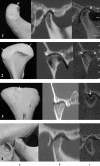A comparative study of accuracy of detection of surface osseous changes in the temporomandibular joint using multidetector CT and cone beam CT
- PMID: 22378752
- PMCID: PMC3520284
- DOI: 10.1259/dmfr/24985971
A comparative study of accuracy of detection of surface osseous changes in the temporomandibular joint using multidetector CT and cone beam CT
Erratum in
- Dentomaxillofac Radiol. 2013;42(7):20139011
Abstract
Objective: The aim of this study was to assess the accuracy and reliability of cone beam CT (CBCT) images compared with multidetector CT (MDCT) images for the detection of surface osseous changes in temporomandibular joints (TMJs).
Methods: Naked-eye inspection of 110 sites in 10 TMJs from 5 dry human skulls provided the gold standard. Two radiologists interpreted the images. Sensitivity, specificity and kappa statistics were used for analysis.
Results: The sensitivities of both modalities were low and comparable whereas the specificities were high and comparable. Intraobserver reliabilities for CBCT (p=0.0005) and for MDCT (p=0.0001) showed significant agreement. Interobserver reliability was higher for CBCT than for MDCT.
Conclusion: CBCT and MDCT accuracy was comparable in detecting surface osseous changes with comparable intraobserver reliabilities. However, since CBCT requires less radiation exposure, it should be encouraged for imaging TMJ with suspected surface osseous changes.
Figures



Similar articles
-
Diagnostic performance of magnetic resonance imaging for detecting osseous abnormalities of the temporomandibular joint and its correlation with cone beam computed tomography.Dentomaxillofac Radiol. 2010 Jul;39(5):270-6. doi: 10.1259/dmfr/25151578. Dentomaxillofac Radiol. 2010. PMID: 20587650 Free PMC article.
-
Effect of Field of View on Detection of Condyle Bone Defects Using Cone Beam Computed Tomography.J Craniofac Surg. 2016 May;27(3):644-8. doi: 10.1097/SCS.0000000000002592. J Craniofac Surg. 2016. PMID: 27092920
-
Assessment of a training programme on detection of temporomandibular joint osseous changes applying pre-defined 2D multiplane cone beam computed tomography reconstructions.J Oral Rehabil. 2018 Apr;45(4):282-288. doi: 10.1111/joor.12610. Epub 2018 Feb 14. J Oral Rehabil. 2018. PMID: 29377222
-
Application of cone beam computed tomography for assessment of the temporomandibular joints.Aust Dent J. 2012 Mar;57 Suppl 1:109-18. doi: 10.1111/j.1834-7819.2011.01663.x. Aust Dent J. 2012. PMID: 22376103 Review.
-
Cone beam computed tomography imaging in the evaluation of the temporomandibular joint.J Calif Dent Assoc. 2010 Jan;38(1):33-9. J Calif Dent Assoc. 2010. PMID: 20178225 Review.
Cited by
-
Assessment of condylar morphology and position using MSCT in an Asian population.Clin Oral Investig. 2018 Sep;22(7):2653-2661. doi: 10.1007/s00784-018-2364-7. Epub 2018 Feb 1. Clin Oral Investig. 2018. PMID: 29388022
-
Three-dimensional CBCT images registration method for TMJ based on reconstructed condyle and skull base.Dentomaxillofac Radiol. 2018 Jul;47(5):20170421. doi: 10.1259/dmfr.20170421. Epub 2018 May 2. Dentomaxillofac Radiol. 2018. PMID: 29595332 Free PMC article.
-
Cone beam computed tomography in the assessment of TMJ deformity in children with JIA: repeatability of a novel scoring system.BMC Oral Health. 2023 Jan 10;23(1):12. doi: 10.1186/s12903-022-02701-5. BMC Oral Health. 2023. PMID: 36627622 Free PMC article.
-
Interdisciplinary Approach to the Temporomandibular Joint Osteoarthritis-Review of the Literature.Medicina (Kaunas). 2020 May 9;56(5):225. doi: 10.3390/medicina56050225. Medicina (Kaunas). 2020. PMID: 32397412 Free PMC article. Review.
-
Is the retromandibular approach a suitable approach to anatomical reduction of unilateral subcondylar fracture? A non-randomized clinical trial.Head Face Med. 2022 Dec 2;18(1):38. doi: 10.1186/s13005-022-00342-1. Head Face Med. 2022. PMID: 36461049 Free PMC article. Clinical Trial.
References
-
- Cohen H, Ross S, Gordon R. Computerized tomography as a guide in the diagnosis of temporomandibular joint disease. J Am Dent Assoc 1985;110:57–60 - PubMed
-
- Lewis EL, Dolwick MF, Abramowicz S, Reeder SL. Contemporary imaging of the temporomandibular joint. Dent Clin North Am 2008;52:875–890, viii - PubMed
-
- Honey OB, Scarfe WC, Hilgers MJ, Klueber K, Silveira AM, Haskell BS, et al. Accuracy of cone-beam computed tomography imaging of the temporomandibular joint: comparisons with panoramic radiology and linear tomography. Am J Orthod Dentofacial Orthop 2007;132:429–438 - PubMed
-
- Cara AC, Gaia BF, Perrella A, Oliveira JX, Lopes PM, Cavalcanti MG. Validity of single- and multislice CT for assessment of mandibular condyle lesions. Dentomaxillofac Radiol 2007;36:24–27 - PubMed
-
- Draenert FG, Coppenrath E, Herzog P, Muller S, Mueller-Lisse UG. Beam hardening artefacts occur in dental implant scans with the NewTom cone beam CT but not with the dental 4-row multidetector CT. Dentomaxillofac Radiol 2007;36:198–203 - PubMed
Publication types
MeSH terms
LinkOut - more resources
Full Text Sources
Medical

